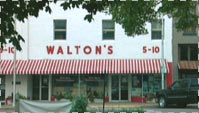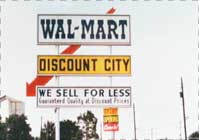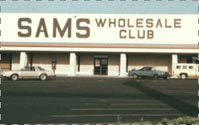|
 |
 |  |  |  |  |  |
|
A chronology of Wal-Mart's stunning growth from its humble, small-town origins to the world's largest company. | |
 |
 |
March 29, 1918 | Sam Moore Walton born |
Wal-Mart founder Sam Walton is born in Kingfisher, Okla. just before the Great Depression. In his autobiography, Walton writes, "No question about it, a lot of my attitude toward money stems from growing up during a pretty hardscrabble time in our country's history: the Great Depression."
|  |
 |
1940 | Walton graduates from college, starts working retail at JCPenney |
After graduating from the University of Missouri with a business degree, Walton goes to work for the retail department store giant, JCPenney, in Des Moines, Iowa, as a $75-a-month trainee. From 1942 to 1945, Walton serves in the Army, supervising security at aircraft plants and POW camps in the U.S.
|  |
 |
Sept. 1, 1945 | Sam Walton opens his first retail store |
After borrowing $20,000 from his father-in-law, the 27-year-old Walton purchases his first franchise, a Ben Franklin variety store in the tiny delta town of Newport, Ark. In four short years, he turns a money-losing store into the number one Ben Franklin franchise in the state. Walton seeks to maintain a competitive advantage by surveying rival stores to assess their pricing and display strategies. He also begins negotiating directly with manufacturers for goods, rather than following the existing pricing structures set out by Butler Brothers, the parent company of Ben Franklin.
In 1949, Walton loses the lease on his store in Newport. He wants to buy a department store in St. Louis, but his wife Helen insists that she wants to live in a small town, no larger than 10,000 residents -- a decision that will have implications for Wal-Mart's growth strategy, as small-town communities were a relatively untapped population for discount retailers.
|  |
 |
1951 | The first Walton 5 and 10 opens in Bentonville, Ark. |

Walton operates the Walton 5 and 10 as a Ben Franklin franchise. Two years later, he opens a second store in nearby Fayetteville, Ark. By 1962, he is the largest Ben Franklin franchise owner in the U.S., with 16 stores in Arkansas, Kansas and Missouri.
Walton's experience with the Ben Franklin stores makes him realize that there is an opportunity for discount stores that promise consistently low prices in small and rural communities. He tries to convince Butler Brothers of this idea, but they deny Walton the opportunity to experiment with his franchises.
|  |
 |
July 2, 1962 | The first Wal-Mart Discount City opens in Rogers, AR |

After the rejection from Butler Brothers, Sam Walton and his younger brother, Bud, open their first discount store, Wal-Mart Discount City in Rogers, Ark. The store is twice as big as the original Walton 5 and 10 in Bentonville and sales are $975,000 in the store's first year.
Three other future retail giants open their doors in 1962: the first Kmart opens in Garden City, Mich.; Woolworth's department store opens its Woolco discount chain; and Dayton Hudson opens the first Target store. Within five years, Wal-Mart has 18 stores with sales of $9 million; while Kmart has 250 stores, with sales of more than $800 million.
|  |
 |
October 1970 | Wal-Mart becomes a publicly-traded company |
By 1970, Wal-Mart has 38 locations and sales of $44.2 million, and is opening an average of two stores a year; however Sam Walton's debts total several million dollars. Walton struggles with the decision to go public, but he needs the cash to pay off his debts and open more stores. When the company goes public, the Walton family owns 61 percent of the stock.
|  |
 |
1975 | Sam Walton introduces the "Wal-Mart cheer" |
After seeing employees at a South Korean tennis ball factory reciting a morning cheer, Walton introduces the "Wal-Mart cheer" to his own company. The cheer, recited by employees around the world, becomes an integral part of Wal-Mart's culture.
The Wal-Mart cheer is:
Give me a W!
Give me an A!
Give me an L!
Give me a Squiggly! (At which point, the employees do a little shimmy.)
Give me an M!
Give me an A!
Give me an R!
Give me a T!
What does that spell?
Wal-Mart!
What does that spell?
Wal-Mart!
Who's number one?
The customer! Always!
|  |
 |
1979 | Wal-Mart reaches a sales milestone |
With 276 stores and 21,000 employees, Wal-Mart reaches $1 billion in sales in 1979. Having only been in existence for 17 years, the company achieves the quickest ever ascent to the $1 billion milestone. However, because of Walton's aversion to the press and his decision to remain headquartered in Bentonville, Wal-Mart's growth during the 1970s remains relatively under the radar.
|  |
 |
Early 1980s | Attempt to unionize Wal-Mart distribution center |
The attempt to unionize Wal-Mart's Searcy, Ark., distribution center fails; Walton threatens to remove the employees' profit-sharing plan if the union vote passes and warns that he has more than 500 potential employees lined up to take their jobs.
More on Wal-Mart and unions.
|  |
 |
1983 | First Sam's Club opens |

Wal-Mart begins to own and operate large, discount warehouses known as Sam's Clubs; the first opens in Midwest City, Okla. The warehouses occupy 100,000 square feet or more and are primarily targeted to small businesses. By 1987, there are more than 52 Sam's Clubs nationwide.
|  |
 |
March 1985 | Walton launches "Buy America" program |
In response to the soaring U.S. trade deficit, Walton launches Wal-Mart's "Buy America" program. Noting that 1.6 million U.S. jobs had been lost between 1981 and 1984, he announces the campaign in a letter to 3,000 U.S. Wal-Mart suppliers. Wal-Mart receives much positive publicity for the campaign, but the reality is complicated, as Walton admits in his autobiography. "The remedy we envisioned wasn't some blind patriotic idea that preaches buying American at any cost," he recalls. "We, like any other retailer, will only buy American if those goods can be produced efficiently enough to offer good value."
|  |
 |
October 1985 | Walton begins to receive media scrutiny |
Estimating his net worth at $2.8 billion, Forbes Magazine names Walton as the richest man in America, and the national media flocks to Arkansas to profile the billionaire who lives in a modest house in Bentonville and eschews chauffeur-driven limousines for his old pickup truck. Walton later complains in his memoirs about being characterized as "a really cheap, eccentric recluse, sort of a hillbilly who more or less slept with his dogs in spite of having billions of dollars stashed away in a cave."
|  |
 |
1987 | Wal-Mart opens its first Hypermart |
The Hypermarts, large stores that combine general merchandising with groceries and other services, are modeled after the Carrefours stores in Brazil. The first Hypermart opens in Garland, Texas, and Wal-Mart opens three others: one in the Dallas-Ft. Worth area, one in Topeka and one in Kansas City. The experiment fails, in large part because the company is unaccustomed to operating on such a massive scale.
|  |
 |
1988 | First Wal-Mart Supercenter opens; Walton implements a succession plan |
The Supercenter concept builds upon the hybrid grocery store/general merchandise concept first tried with the Hypermarts. The first Supercenter, which is smaller than the Hypermarts, opens in Washington, Mo. and this time, after a period of slow growth, the concept takes off.
|  |
 |
1989 | Wal-Mart reaches another sales milestone |
At the end of the year, Wal-Mart becomes the first retailer in history to report after-tax profits of $1 billion. The company, with 1,402 stores and 272,000 employees in 26 states, surpasses Kmart to become the most profitable retailer in America.
|  |
 |
1991 | Wal-Mart expands beyond U.S. borders |
The first international Wal-Mart store, a Sam's Club, opens in Mexico City, Mexico. By 2004, the company has 1,500 stores in nine countries: Argentina, Brazil, Canada, China, Germany, Japan, Korea, Mexico and the U.K.
|  |
 |
April 5, 1992 | Sam Walton dies of bone cancer |
A month after receiving the Presidential Medal of Freedom in Wal-Mart's home office in Bentonville from President George Bush, Walton dies of bone cancer. At the time of his death, Walton is the world's second-richest man, and Wal-Mart's annual revenue is $43 billion. The company operates 1,714 stores and 208 Sam's Clubs in the U.S., and eight stores in Mexico and Puerto Rico.

Observers wonder what will become of the company so identified with its founder. David Glass, who had been named president and CEO in 1988, proves to be less frugal than Wal-Mart's founder: Unlike Walton, he is willing to spend money on technology, and to take on debt to build more Supercenters because he foresees the company's future to be in food retailing. By 1995, three years after Walton's death, Wal-Mart sales have more than doubled to $100 billion; however during the same period, with a sluggish economy, the company's stock price loses $7.7 billion in value. By the late 1990s, Wal-Mart becomes dependent on low-cost Asian imports to stock its stores and the company begins pushing its U.S. suppliers to Asia.
|  |
 |
December 1992 | Made in America? |
The NBC television series Dateline airs an investigation into Wal-Mart's "Made in America" and "Bring It Home to the USA" marketing campaigns. The show airs footage of children working in factories in Bangladesh to make clothes destined for Wal-Mart, as well as hidden camera footage of Wal-Mart stores with "Made in America" signs hung over imported goods. The program also profiles a sweater factory in North Carolina that was featured in a Wal-Mart "Buy America" ad but was forced to close when Wal-Mart found a cheaper distributor overseas. Wal-Mart CEO David Glass storms out of the Dateline interview, and according to former Wal-Mart store manager Jon Lehman, the stores are required to remove the "Made in America" signs overnight.
|  |
 |
August 1996 | Wal-Mart enters China |

Wal-Mart opens a Supercenter and a Sam's Club in Shenzhen, China. On the first day, 80,000 people shop at the store.
|  |
 |
1999 | Wal-Mart establishes government affairs unit |
Although Sam Walton prided himself on getting involved in the political process, by 1999, Wal-Mart executives realize that the company has grown such that it cannot afford not to have a Washington presence.
Read more on Wal-Mart's lobbying operation.
|  |
 |
2000 | Wal-Mart gets a new chief |
H. Lee Scott, a low-profile 20-year Wal-Mart veteran and logistics expert, is named to succeed David Glass. Scott continues to build Wal-Mart stores both domestically and internationally and expand Wal-Mart's grocery business. Under Scott, the company also begins to cultivate more openness with the media to combat its damaged reputation.
|  |
 |
2001 | America's number one grocer |
Wal-Mart reaches grocery sales of $56 billion, making it the largest food retailer in the U.S., with a 16 percent market share.
|  |
 |
June 7, 2002 | Wal-Mart tops the Fortune 500 list |
Earning $219.8 billion in revenue in 2001, Wal-Mart finally tops the Fortune 500 list as the biggest company in America, measured by annual revenue. According to Fortune, the company is raking in sales at a rate of $1 billion per day. The magazine also notes that Wal-Mart is the first service company to top the list.
|  |
 |
October 2003-February 2004 | Supermarket strike in California |
Approximately 70,000 unionized supermarket workers from three Southern California-based grocery chains strike for four months to protest reductions in health care costs and other benefits that the stores argue are necessary to compete with Wal-Mart, which had announced plans to open 40 Supercenters in Southern California. In February 2004, the two sides agree to a two-tiered system in which the wages and benefits for new workers are significantly lower than those for existing workers.
|  |
 |
October 2003 | Illegal immigrants sting |
Immigration officials arrest 250 janitors at 60 Wal-Mart stores in 21 states on charges of working illegally in the U.S. The majority of those arrested work for contractors. Although Wal-Mart denies any knowledge that the contractors are using illegal immigrants, a federal grand jury starts meeting to investigate allegations that Wal-Mart did know about the workers' immigration status.
In September 2004, Wal-Mart acknowledges in SEC filings that it is settlement talks with federal prosecutors regarding the case.
|  |
 |
April 2004 | Wal-Mart again tops the Fortune 500 list |
With $256 billion in sales, Wal-Mart again heads up Fortune Magazine's list of the 500 largest U.S. companies. For FY2005, the company plans to add 50-55 new Wal-Marts, 220-230 new Supercenters, 35-40 new Sam's Clubs, and 130-140 new international stores, for a total of 50 million square feet of new retail space.
As of Jan. 31, 2004, Wal-Mart has 1,478 Wal-Mart stores, 1,471 Supercenters, 538 Sam's Clubs and 64 Neighborhood Market grocery stores in the United States. Internationally, the company operates 11 stores in Argentina, 15 stores in Brazil, 235 stores in Canada, 34 stores in China, 92 stores in Germany, 15 stores in South Korea, 623 stores in Mexico, 53 stores in Puerto Rico (which Wal-Mart considers to be part of its international operation) and 267 stores in the U.K.
|  |
 |
April 2004 | An uprising in Inglewood |
As Wal-Mart expands into urban areas with traditionally strong union presence, it has faced local opposition. Wal-Mart's biggest defeat is in Inglewood, Calif., a diverse, working-class community near the Los Angeles airport. After the Los Angeles City Council passes an ordinance to block the development of a Wal-Mart Supercenter, the company sponsors an initiative to take the issue directly to Inglewood's residents. Wal-Mart and its allies argue that the Supercenter will provide much-needed jobs, tax revenue and low-priced merchandise to the community; its opponents, a broad-based coalition of clergy, labor activists, community leaders and small-business owners, warn that the retailer's presence would depress wages, cause traffic tie-ups and force small, local businesses to close. Wal-Mart's opponents also argue that in forcing the referendum, the company is trying to circumvent the decisions of the local government.
Although Wal-Mart spends nearly $1 million to support the referendum, the measure fails with 60 percent of voters rejecting the Wal-Mart-backed proposal. The company plays down the vote; "It's a single store," CEO Lee Scott says in an interview with Reuters. "We have lost votes on single stores before, and I would assume in the future we will have some we lose.
Read more on Wal-Mart vs. local communities.
|  |
 |
June 2004 | Gender discrimination suit against Wal-Mart |
A federal judge in San Francisco rules that a gender discrimination suit against Wal-Mart can proceed as a class-action suit. The suit, on behalf of 1.6 million current and former Wal-Mart employees who have worked at Wal-Mart since 1998, is the largest discrimination case in U.S. history. The suit argues that female employees are paid less and offered fewer promotions than male employees. Wal-Mart is appealing the ruling.
|
| |
|
A Note on Sources:
This chronology is drawn from FRONTLINE research and reporting, plus:
Bob Ortega, In Sam We Trust (New York: Random House, 1998)
Robert Slater, The Wal-Mart Triumph (New York: Penguin, 2003)
Sam Walton with John Huey, Made in America: My Story (New York: Doubleday, 1992)
| | |  |
 |
|
|